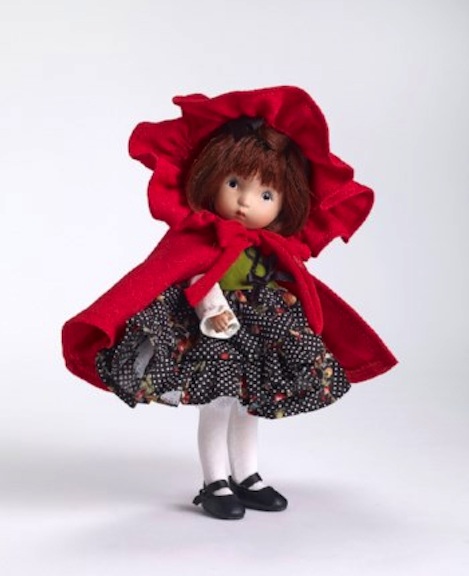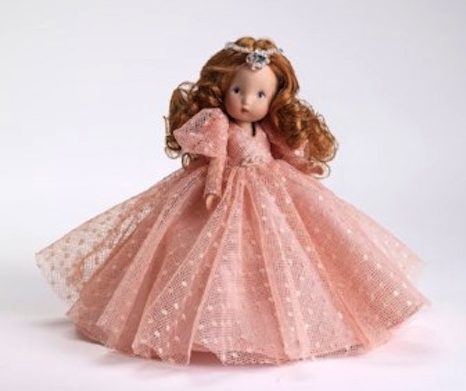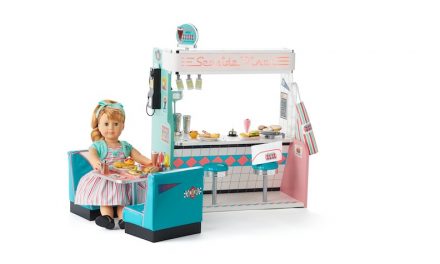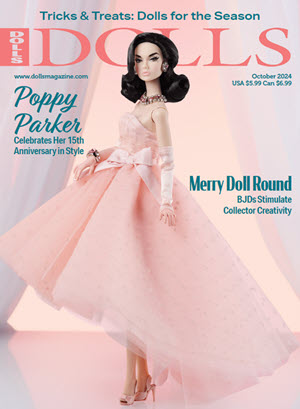
Dianna Effner, backed up by some of her many beautiful and beloved doll creations (Photo by Carl Neitzert of Creative Photo)
It’s a testament to the versatility of Robert Tonner that the announcement of his company Phyn & Aero purchasing and then unveiling brand-new Nancy Ann Storybook Dolls makes an elegant and understandable sense. Yes, Phyn & Aero is more readily known as a business that’s into combining technology with designing mechanisms of the future (think 3-D printing). It’s heralded for its present-day pop culture sensibilities and its sophisticated, adult collectability. (The Ryan Roche line of dolls certainly proves that point.) Yet, despite its positioning as the doll company for grown-ups, the Nancy Ann Storybook Dolls completes the Phyn & Aero circle. Because, let’s face it, if you don’t start loving dolls as a child, you’re vey unlikely to embrace them as an adult.
Nancy Ann Storybook Dolls, then, is both a nod to nostalgia—I’m sure Robert had loved these characters from afar in his boyhood—and a gambit for Tonner to entice new little children into the doll fold. It’s a sad, but true, fact of life: A hobby is only as resilient and exciting, evolutionary and inviting, as its newest members. Tackling Nancy Ann Storybook Dolls is a way for Robert Tonner to be showing that he believes in honoring the history of his art form, and is definitely promoting inclusion of younger and more impressionable collectors, too.

“Sweet Violet” is now available for pre-order shipping from Phyn & Aero. Limited to 200, she’s priced at $109.
The new dolls are sculpted by the very talented Dianna Effner, who excels at capturing wholesome expressions and whimsical loveliness in her dolls’ faces. An Effner doll is always reminiscent of the wonders and open-heartedness of childhood. That’s why it’s a natural fit to have her plying her craftsmanship with the Nancy Ann Storybook Dolls. Imagine Cinderella gliding her foot into the glass slipper—that’s how natural it is for Effner to be the sculpting hands at Nancy Ann. She is the ideal artist to combine the playfulness of a well-loved story with a pure and innocent expression. These newly launched Nancy Ann Storybook Dolls are garbed in wardrobes created by designer Londie Phillips. The blending of character with costume is spot-on perfection.

Limited to 200, and in stock at Phyn & Aero, “Little Red Riding Hood” embodies the sweetness of the Nancy Ann Storybook Dolls.
Perhaps Tonner will also add his formidable skills to the sculpting of some Nancy Ann Storybook Dolls. He’s had the company for a brief time—became interested in purchasing it in 2016—so it is a venture that is still in its infancy in relation to Phyn & Aero. The possibilities are endless, which is both exciting and enticing for collectors. It’s always good to be surprised by a development that one could never have anticipated or predicted. We’ll see what Tonner has in mind for the lineup of lovely little lasses and lads who spring from the pages of beloved bedtime tales and other bygone entertainments.
One of the reasons why Nancy Ann Storybook Dolls initially enjoyed such worldwide acclaim was due to its founder’s penchant for the dramatic and make-believe. Nancy Ann Abbott was an aspiring actress who headed to Hollywood in the 1920s to make her name in motion pictures. At first, Abbott was assigned brief roles as a dancer; these first efforts were considered bit parts, and they weren’t particularly challenging. Eventually, she worked her way up to having co-starring roles in “horse operas,” in other words: westerns.

Nancy Ann Abbott: actress, doll artist, businesswoman, philanthropist, and patriot
According to her obituary in the New York Times, August 12, 1964, Nancy Ann Abbott was remembered as a blue-eyed, redhead beauty. Her associates always thought she’d make it as a leading actress, and they would have wagered that she’d find great success on the silver screen. However, fate interceded in the mid-1930s when a colleague asked her to dress a doll as a gift for a friend. The resulting doll caused a stir. It was a ceramic doll and Nancy Ann had given it a few cute garnishes and unexpected embellishments. People responded to what she had done, and commissioned her to make one for them as well. In under a week, via word of mouth—this was way before social media and overnight meme-dom—she had amassed several hundred orders.
The Times quotes her as saying: “The idea became so popular that I had to drop it. I couldn’t fulfill all the orders.” What an enviable predicament to have! The working actress quickly realized that she was becoming a sensation in the field of play dolls. The East Coast had its Madame Alexander; now, in 1936, the West Coast would have its very own counterpart: Nancy Ann Dressed Dolls. (It didn’t pick up the “Storybook” moniker until a bit later in its formation, in 1945.)

Dorothy from Nancy Ann Storybook Dolls’ “Wizard of Oz” Collection
In addition to dolls, Nancy Ann also oversaw the production of kitchen bowls and plates. During the World War II years, she received a $50,000 contract to manufacture plates, dishes, cups, and platters for the U.S. Navy. By 1944, legend has it that Nancy Ann and her dolls were so popular that she had to have her company’s switchboard disconnected so the phones would stop ringing off the hooks! She couldn’t keep up with the demand for her dressed dolls.
Her factories, which were based out of Berkeley and Stockton, California, were always on the go. As many as 12,000 dolls were produced and shipped per day from these West Coast plants. That’s a mind-boggling statistic. Even more awe-inspiring is her revenue for 1943: a cool $1 million.

The Wicked Witch will be shipping the 3rd quarter of 2018 from Phyn & Aero.
Nancy Ann Storybook Dolls does have a quaint sound to it, and its emphasis on sweetness and purity might seem antiquated and old-fashioned. But when one considers the pioneering woman who masterminded the rise of that business, it’s anything but outdated. Here is a woman who had multiple talents and interests. She was the founder of the San Francisco Orchid Society, a film actress, a patriot, and a tireless entrepreneur.

Glinda the Good Witch presides over the Land of Oz. The Nancy Ann Storybook Doll version will be available for ordering in July 2018 from Phyn & Aero.
At a time when many women were defined by their husbands and their families, Nancy Ann Abbott wrote the storybook on independence. Frequently called “the Doll Lady,” she died at the age of 63, leaving behind a gentle and genteel legacy that has endured, in different guises, for more than 80 years.






